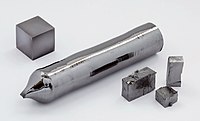
Photo from wikipedia
Abstract Development of a reliable, easily scalable and economically feasible technology for thin-film solid electrolyte fabrication is critical for the industrial production of solid oxide fuel cells (SOFCs). In the… Click to show full abstract
Abstract Development of a reliable, easily scalable and economically feasible technology for thin-film solid electrolyte fabrication is critical for the industrial production of solid oxide fuel cells (SOFCs). In the present work, the aerosol deposition (AD) technique has been appraised for this role. The thin-film membranes of 8 mol.% yttria-stabilized zirconia (8YSZ) solid electrolyte were applied onto two-layer anode supports, with subsequent screen-printing of the composite cathodes made of (La0.8Sr0.2)0.95MnO3–δ (LSM) and zirconia co-stabilized with 10 mol.% scandia and 1 mol.% ceria (10Sc1CeSZ). High quality of the thin membranes produced by the aerosol deposition was confirmed by scanning electron microscopy and electrochemical measurements, including the measurements of current–voltage dependencies and impedance spectroscopy. At 850 °C, the anode-supported SOFCs with wet hydrogen as fuel and air as an oxidant demonstrated the open-circuit voltage above 1.04 V, whilst the power density was higher than 500 mW/cm2.
Journal Title: Materials Letters
Year Published: 2020
Link to full text (if available)
Share on Social Media: Sign Up to like & get
recommendations!